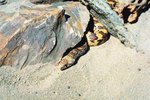
The emerald tree boa (Corallus caninus) is a brightly colored nonvenomous snake of the Boidae family of primitive constrictors. These verdant reptiles are native to the rain forests of northern South America. They spend much of their time in the tree canopies, often draped over branches in their signature looping coil.
Geography and Range
The emerald tree boa's native range is entirely within the northern rain forests of South America, in the Amazonian and Guianas regions of the continent. Emerald tree boas can be found in lowland tropical areas of French Guiana, Guyana, Suriname, Peru, Colombia, Ecuador, Venezuela and in northern sections of Brazil and Bolivia. Populations of emerald tree boas south of the Amazon River and west of its tributary, the Rio Negro, are different enough from the main population to constitute a separate species, suggests a 2009 study published by The American Society of Ichthyologists and Herpetologists.
Habitat Features
Emerald tree boas are arboreal or tree-dwelling snakes. They require a habitat that is heavily forested, normally rain forests with low elevation, though they also are found in forested swamps. These snakes prefer a wet habitat, often choosing areas of the Amazon Basin close to rivers, though open water isn't necessary. One feature of all emerald tree boa habitats, regardless of proximity to open water, is plenty of rain. Their habitats receive more than 59 inches of rain every year.
Adaptations
Emerald tree boas have several adaptations to thrive in their treetop habitat. They spend most of their lives in the forest canopy, rarely visiting the ground. Their color allows them to blend in with the bright green foliage of their surroundings, and their ability to coil tightly into crooks of trees gives them further camouflage. Emerald tree boas' prehensile tails allow them to easily climb and move between tree limbs, and they enable these snakes to hang from branches to ambush their prey.
Ecological Role
Emerald tree boas fill an important ecological niche in their habitat. They provide a food source for Guianan crested eagles, though their excellent camouflage makes them difficult targets even for the eagle-eyed. More important, emerald tree boas help control the population of small mammals within their habitat, feeding primarily on rodents and small marsupials. When hunting, emerald tree boas typically hang from branches until the heat-sensing pits along their lips detect prey below.
References
Photo Credits
-
Jupiterimages/Photos.com/Getty Images




